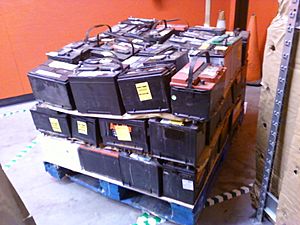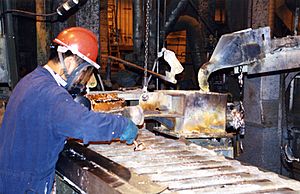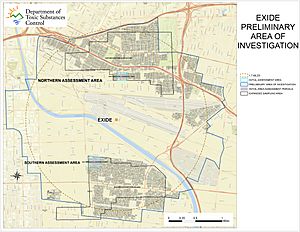Exide lead contamination facts for kids
Exide is one of the world's biggest companies that makes, sells, and recycles lead-acid batteries. These batteries are used in many things like cars, golf carts, forklifts, and motorcycles. To recycle them, workers grind them open, clean out the acid, and separate the plastics from the lead and copper. In the U.S., about 97% of the lead from car batteries is recycled. This is the highest recycling rate for any material! Most states even require stores to take back old batteries.
However, since 2010, some of Exide's battery plants have caused serious health risks to the environment and people living nearby. These plants have released harmful metals like lead into the air and soil. This has happened in places like Philadelphia, Los Angeles County, Frisco, Texas, Muncie, Indiana, Salina, Kansas, Bristol, Tennessee, Reading, Pennsylvania, and Forest City, Missouri.
Contents
Lead Pollution in Los Angeles County, California
A battery recycling plant in Vernon, located in Los Angeles County, released toxic metal dust for many years. This dust polluted up to 10,000 homes in several working-class, Latino neighborhoods close to the plant. Lead is a harmful substance that can hurt many body parts, especially the brain. It can cause problems with learning, development, and even how people think and feel. Exide Technologies, the company that owned this smelting plant, agreed in 2015 to close it down. A huge cleanup of the contaminated soil is now underway, which will take years and cost a lot of money.
How the Problem Started
The battery recycling plant was quite large, covering about 15 acres in Vernon, an industrial area. It processed over 11 million used lead batteries every year. The plant operated for a long time with only a temporary permit, even though there were reports of problems. Exide bought the plant in 2000. By 2013, federal officials were investigating Exide for releasing high levels of harmful pollution from the plant. For years, many residents had complained about Exide's toxic emissions before state and federal groups finally took action. In March 2015, Exide signed an agreement to close the plant for good. The company also agreed to pay $50 million to tear down and clean up the plant and nearby communities, including $9 million to remove lead from homes.
Impact on the Environment and People
The soil under the plant had very high levels of toxic metals. The groundwater was also polluted, and harmful sulfates even leaked onto public streets.
Studies showed that as many as 10,000 homes in several working-class, Latino communities near the plant had their homes and yards polluted by lead. The air pollution from the Exide plant over many years may have affected nearby areas like Boyle Heights, Maywood, East Los Angeles, Commerce, Bell, and Huntington Park.
People living there had been worried for a long time about the plant's air pollution. It was found to release lead, arsenic, and other dangerous substances. Lead is a powerful neurotoxin, which means it can harm the brain and nervous system. Children are especially at risk for learning difficulties, lower IQ scores, and other developmental problems if they get lead poisoning from playing outside in contaminated areas.
Testing and Cleaning Up the Pollution
The California Department of Toxic Substances Control (DTSC) and the South Coast Air Quality Management District (SCAQMD) are in charge of closing and cleaning up the facility. The cleanup involves taking apart the old recycling plant inside a special tent that keeps emissions from escaping. Hazardous materials from the plant are either recycled or safely disposed of under DTSC supervision.
The DTSC is also overseeing the cleanup of lead-polluted soil. In August 2015, the department announced that tests showed toxic dust had left lead in up to 10,000 homes. Officials said they had never dealt with such a large lead cleanup before.
Nineteen homes were chosen first for cleanup, starting in December 2014, based on test results. In August 2015, residents in Boyle Heights and Maywood were told they could have their soil tested. These areas were identified as most likely to be polluted. Contaminated soil was removed and replaced at 146 homes closest to the plant.
In October 2015, the Los Angeles County Board of Supervisors decided to spend $2 million to speed up the cleanup. They hired workers to test soil at 1,000 homes and sent outreach workers to neighborhoods. They also pushed state regulators and Exide to fully pay for and do the cleanup. By February 2016, county teams started testing soil in Commerce. The state set aside $176.6 million to test and clean about 2,500 of the most polluted yards. There are also plans for a job training program to hire community members for the cleanup work.
High lead levels were found in the soil at Lorena and Rowan Elementary Schools in summer 2015.
In fall 2017, the DTSC began removing lead-polluted soil from 2,500 homes near the closed Exide plant. This is thought to be the biggest environmental cleanup of its kind in California's history, covering seven Los Angeles County neighborhoods. State officials believe Exide's operations may have put the health of about 100,000 people and 10,000 homes at risk. California has approved $192 million for this huge cleanup effort.
However, the $192 million from the state will only cover the cleanup of 2,500 homes, even though an estimated 10,000 homes were polluted. The total cost to clean up all 10,000 homes is believed to be over $500 million. By August 2016, over $42 million of the $192 million had already been spent.
Community groups and officials have pushed for Exide, not taxpayers, to pay for the extra cleanup money needed. The South Coast Air Quality Management District even filed claims against Exide for over $80 million. Exide, however, has tried to avoid paying, suggesting other causes for lead poisoning like old paint. In October 2020, a judge allowed Exide to be released from its cleanup responsibilities, meaning taxpayers will likely pay for the rest of the cleanup.
In February 2020, California's state auditor decided to investigate how the DTSC is handling the cleanup, looking into contracts and cleanup times.
New Laws to Help
In 2015, the state set aside about $7 million to test and clean homes. In 2016, the state assembly voted to provide $176.6 million more for the cleanup. During a meeting in January 2016, Assemblyman Jimmy Gomez pointed out that the state acted very quickly to clean up a gas leak near a wealthy community (Porter Ranch), but the cleanup in the low-income, Latino neighborhoods near Exide was much slower. He said, "We don't want to send the wrong message. That if you live ... in Porter Ranch that you're more important than the folks that live in East ... or Southeast Los Angeles."
At that same meeting, Assembly Speaker Anthony Rendon said the DTSC "has not done a good job" and urged officials to act faster. The long-term and widespread lead pollution raised concerns about ongoing problems at the department. This situation prompted the Governor and state lawmakers to consider new laws and reforms.
In May 2018, the California state Assembly approved a plan to provide $16 million to clean public parkways. This money would come from a 2016 law that raised about $176 million for the Exide cleanup by adding a fee to batteries for manufacturers and consumers. If this new plan becomes law, the total cost of the taxpayer-funded Exide cleanup would go over $200 million.
Exide's Pollution Record Across the U.S.
The U.S. Environmental Protection Agency (EPA) keeps a list of areas that don't meet safe air quality standards for lead emissions. Out of 21 such areas across the country, Exide has operations in six of them. This means Exide is responsible for nearly one-third of the places that violate federal lead air quality rules. These Exide plants are in Frisco, TX; Vernon, CA; Muncie, IN; Salina, KS; Reading, PA; and Bristol, TN.
Muncie, Indiana
Between 1989 and 2015, Exide Technologies released over 227,275 pounds of harmful pollutants, including lead, sulfuric acid, and arsenic, into the air and water in Muncie, Indiana. Exide operates a lead-acid battery recycling plant there.
In November 2010, Muncie was put on the EPA's list for having too much toxic lead in the air, mainly due to emissions from the Exide plant.
In March 2015, Exide agreed to pay an $820,000 fine for breaking the Clean Air Act at its Muncie plant. These violations led to more lead and other harmful particles being released into the air.
In October 2015, the Department of Justice and Exide did not agree to requests from Muncie's mayor and environmental groups to install $31 million worth of pollution-control equipment at the plant. These groups wanted better protection for people from lead and arsenic released by Exide.
In February 2017, the Exide plant in Muncie had three explosions and leaks that were not fully or quickly reported to state and federal agencies. Local residents didn't find out about these until January 2018, raising worries about risks to the environment and the health of families living nearby.
A year later, in February 2018, it was reported that Exide workers might have carried lead home on their clothes, exposing their children to the toxic metal. The local health department also complained about a recent increase in high blood lead levels in the community, with some cases linked to the Exide plant.
Residents in Muncie are now very concerned about Exide's plant and how decades of toxic emissions might have affected their health and safety. Many have asked for testing of the air, soil, and water around the plant.
Salina, Kansas (High Lead Levels in Children)
Exide Technologies has a large lead-acid battery plant in Salina, Kansas. From 1987 to 2015, Exide released over 166,077 pounds of lead, antimony, arsenic, and other pollutants into Salina's air and water. Between 2010-2013 and in 2016, Exide broke lead release limits over 18 times. In 2010, the plant was a main reason why Salina was named one of 16 areas in the U.S. with too much toxic lead in the air.
Over the years, residents have worried about the plant and wondered if it was connected to reports of higher lead levels in children's blood in Saline County (where Exide operates) compared to other Kansas counties. From 2000-2010, the average blood lead levels in Saline County were 16.5 micrograms per deciliter, more than double the average of 7.5 in other Kansas counties. Children in Salina city also had higher average blood lead levels than children in other Kansas areas.
In 2016, the Kansas Department of Health and Environment (KDHE) held a meeting after doctors found high lead levels in 32 children in Saline County, mostly from Salina. This followed reports of high lead levels in 84 children between 2013-2015.
Some residents at the 2016 meeting asked if officials were investigating a link between these high lead levels and Exide's plant. However, KDHE representatives said the plant had reduced its lead emissions since 2012. They didn't mention that Exide still released 6,720 pounds of lead into the air during that time (2012-2015). KDHE also didn't show any plans to test the soil or groundwater near the plant for lead.
KDHE also tried to shift focus away from Exide by showing a map of where the 32 children with high lead levels lived, many not right next to the plant. But they didn't mention that full blood testing wasn't done for families near the plant, and that results only came from cases reported by doctors. Also, children of plant employees, who are exposed daily to lead, live all over the city.
So far, no major government action has been taken to solve this problem. The source of the high lead levels in children in Salina, Kansas, remains a mystery.
Reading, Pennsylvania (Ongoing Cleanup)
Exide operates a lead smelter and recycled lead batteries in Reading, Pennsylvania. In 1996, the EPA found that Exide caused lead emissions and toxic pollution that affected the soil in the surrounding community. This required a big cleanup of harmful substances in the area.
In 2012, Exide announced it would stop its lead-recycling operations in Reading/Laureldale and laid off 150 workers. They planned to keep their permits active in case they wanted to reopen later. In 2015, Berks County tried to take legal action to get better air-pollution monitoring near the Exide facility. However, a federal court denied their request to move or add an air monitor. The County Commissioner said the appeal was to protect the community from air pollution if the plant reopened.
Lead Pollution Returns After Cleanup
In 2017, a newspaper reported on a study that found lead levels were still high in the area, even after the EPA ordered cleanup efforts about two decades ago at hundreds of properties near the Exide plant. Reporters and a chemistry professor found strong signs that many years of toxic emissions from Exide's battery factory in Reading were still harming nearby properties.
This news worried residents about Exide's past pollution and its effects on their health. There was a story about a family asking for help to find out why they had lead poisoning. Another story talked about a high school reunion and how local industry pollution might be why many classmates had passed away too soon.
Because of the study's findings, State Senator Judy Schwank asked for a review of the original cleanup. Lawmakers also created a group to look at Pennsylvania's lead problem and suggest changes to how the state tests and cleans up lead pollution. The U.S. Army Corps of Engineers took soil samples from homes to see if lead levels were still a health risk. In late 2017, the federal EPA started cleaning up lead-polluted soil from the closed Exide plant. The cleanup is ongoing, and it seems taxpayers are paying for it, not Exide.
Bristol, Tennessee
In 2008, it was reported that Exide was releasing twice the allowed amount of pollutants into the environment from its lead-acid battery plant in Bristol, Tennessee. Instead of fixing the problem, Exide asked the state to double the emissions limit. It was also reported that Exide was doing its own testing, and the state's air pollution control division seemed unaware of the pollution levels.
In 2013, Exide closed the facility and laid off hundreds of workers in Bristol. This happened after they received $34.3 million in federal money and up to $15 million in state tax benefits for their plants in Bristol and Columbus, Georgia. Exide had promised to invest this money in Bristol and create new jobs, but instead, they closed the plant.
In March 2017, Exide applied to the State of Tennessee to restart some operations at the closed plant. Hundreds of residents worried about Exide reopening and demanded a public meeting. Due to pressure for a public meeting and more safety monitoring, Exide decided to withdraw its application to reopen in April 2017.
Frisco, Texas (Toxic Pollution and Cleanup)
From 2001 to 2012, Exide Technologies received 50 written warnings for unsafe working conditions at its Frisco lead-acid battery recycling plant. The Texas Commission on Environmental Quality (TCEQ) found 27 violations at the plant between 2009 and 2010. These included soil and water pollution and signs of toxic waste that worried officials about downstream waters. Between May and June 2011, the TCEQ investigated Exide's Frisco plant four times and found dangerous levels of lead and cadmium, which could make the site a Superfund site (a place with serious hazardous waste pollution that needs a long-term cleanup).
The Exide plant stopped operating in 2012 after a $45 million agreement with the city of Frisco. Exide agreed to clean the land to federal standards before giving it to the city. However, Exide has not fully cooperated with Frisco, which believes Exide is downplaying the pollution to save money on cleanup. Frisco's spokesperson also said the city's estimated $20 million for cleanup would not be enough.
Community Action for Environmental Justice
Community activists are leading a growing national discussion about environmental justice. This idea means that all communities, no matter their race or income, should have the same good environmental quality and protection. One important leader in this movement is mark! Lopez, who received an award in 2017 for his work with East Yard Communities for Environmental Justice. His group helped address the terrible lead pollution in East and Southeast Los Angeles, where the Exide plant had broken environmental rules for over 30 years while state regulators didn't act. Lopez and others pushed state lawmakers to take action after decades of complaints from residents were ignored.
Community activists and environmental experts have argued that big polluters like Exide have been able to release huge amounts of pollution because governments haven't acted enough to protect poor and minority communities, which often live near these polluting sites. Some have suggested that Exide was protected by local agencies, giving the company little responsibility in low-income, minority communities. For example, the mayor of Maywood, Oscar Magana, believed that if the Exide plant in Vernon had been in a wealthy area like Beverly Hills, it would have been closed much sooner.




